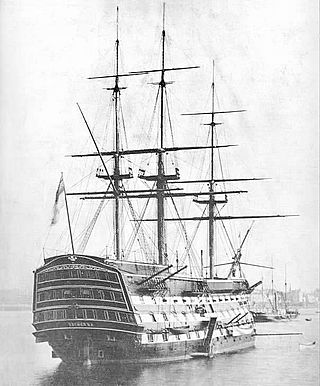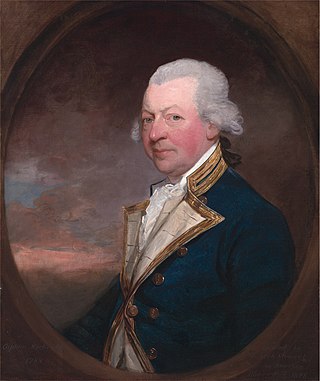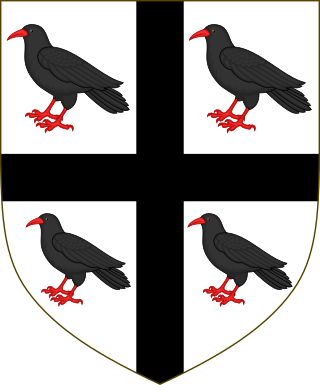
In the rating system of the British Royal Navy used to categorise sailing warships, a first rate was the designation for the largest ships of the line. Originating in the Jacobean era with the designation of Ships Royal capable of carrying at least 400 men, the size and establishment of first-rates evolved over the following 250 years to eventually denote ships of the line carrying at least 80 guns across three gundecks. By the end of the eighteenth century, a first-rate carried no fewer than 100 guns and more than 850 crew, and had a measurement (burthen) tonnage of some 2,000 tons.
Two ships of the Royal Navy have borne the name HMS Duke of York, after numerous holders of the title of Duke of York :

USS President was a wooden-hulled, three-masted heavy frigate of the United States Navy, nominally rated at 44 guns; she was launched in April 1800 from a shipyard in New York City. President was one of the original six frigates whose construction the Naval Act of 1794 had authorized, and she was the last to be completed. The name "President" was among ten names submitted to President George Washington by Secretary of War Timothy Pickering in March of 1795 for the frigates that were to be constructed. Joshua Humphreys designed these frigates to be the young Navy's capital ships, and so President and her sisters were larger and more heavily armed and built than standard frigates of the period. Forman Cheeseman, and later Christian Bergh were in charge of her construction. Her first duties with the newly formed United States Navy were to provide protection for American merchant shipping during the Quasi War with France and to engage in a punitive expedition against the Barbary pirates in the First Barbary War.

Prince Edward, Duke of York and Albany, was the younger brother of George III of the United Kingdom and the second son of Frederick, Prince of Wales, and Princess Augusta of Saxe-Gotha.

Admiral Augustus Keppel, 1st Viscount Keppel, PC was a Royal Navy officer and politician who sat in the House of Commons from 1755 to 1782. He saw action in command of various ships, including the fourth-rate Maidstone, during the War of the Austrian Succession. He went on to serve as Commodore on the North American Station and then Commander-in-Chief, Jamaica Station during the Seven Years' War. After that he served as Senior Naval Lord and then Commander-in-Chief of the Channel Fleet.

HMS Centurion was a 60-gun fourth rate ship of the line of the Royal Navy, built at Portsmouth Dockyard by Joseph Allin the younger and launched on 6 January 1732. At the time of Centurion's construction, the 1719 Establishment dictated the dimensions of almost every ship being built. Owing to concerns over the relative sizes of British ships compared to their continental rivals, Centurion was ordered to be built 1 ft (0.3 m) wider across the beam than the Establishment prescribed. HMS Rippon was similarly built to non-Establishment dimensions at the same time.

Admiral Sir Henry William Bayntun GCB was a senior officer in the Royal Navy, whose distinguished career in the French Revolutionary and Napoleonic Wars was a catalogue of the highest and lowest points of the Navy during the conflict. His record includes extensive operations in the West Indies followed by shipwreck, the battle of Trafalgar and the disastrous expedition to Buenos Aires in 1807.

HMS Northumberland was a 70-gun third-rate ship of the line of the Royal Navy, built at Deptford Dockyard and launched in 1705.

HMS Duke was a 90-gun second-rate ship of the line of the Royal Navy, launched on 13 June 1682 at Woolwich Dockyard.
HMS Fly was a Swan-class ship sloop of the Royal Navy, launched on 14 September 1776. She performed mainly convoy escort duties during the French Revolutionary Wars, though she did capture three privateers. She foundered and was lost with all hands early in 1802.

John MacBride was a British officer of the Royal Navy and a politician who saw service during the Seven Years' War, the American War of Independence and the French Revolutionary Wars, eventually rising to the rank of Admiral of the Blue.
His Majesty's Hired armed lugger Duke of York served the Royal Navy from 14 October 1794 to 2 January 1799 when she foundered in the North Sea. She was of 5744⁄94 tons (bm) and was armed with eight 4-pounder guns.
HMS Montreal was a 32-gun Niger-class fifth-rate frigate of the Royal Navy. She was launched in 1761 and served in the Seven Years' War and the American War of Independence. The French captured her in 1779 and she then served with them under the name Montréal. An Anglo-Spanish force destroyed her during the occupation of Toulon early in the French Revolutionary Wars.

During the eighteenth and nineteenth centuries the Royal Navy made use of a considerable number of hired armed vessels. These were generally smaller vessels, often cutters and luggers, that the Navy used for duties ranging from carrying despatches and passengers to convoy escort, particularly in British coastal waters, and reconnaissance.

HMS Galatea was a Jason-class 26-gun, sixth-rate, wooden screw frigate in the Royal Navy, launched in 1859 and broken up 1883.
The Swan class were built as a 14-gun class of ship sloops for the Royal Navy, although an extra two guns were added soon after completion.
HMS Friendship was a 4-gun single-masted cutter of the Royal Navy, purchased in 1763 for coastal patrol duties in the immediate aftermath of the Seven Years' War with France. After eight years service in Start Bay in Devon, she was declared surplus to Navy requirements and sold out of service at Plymouth.
Rear-Admiral George Murray, 6th Lord Elibank was a British naval officer. He joined the Royal Navy in the early 1720s and fought in the Battle of Porto Bello in 1739 as a lieutenant on board the ship of the line HMS Hampton Court. Murray was promoted to commander in 1740 and given command of the sloop HMS Tryall to take part in George Anson's voyage around the world. A series of illnesses and deaths in Anson's squadron meant that by early 1741 Murray had been promoted to post captain and given command of the frigate HMS Pearl. Pearl and another ship lost contact with Anson in April of that year and after taking heavy damage and casualties through storms and sickness, sought safety in Rio de Janeiro before sailing for England.

Captain Henry Aylmer, 3rd Baron Aylmer was a Royal Navy officer and hereditary peer of the eighteenth century. He served during the War of the Austrian Succession and fought at the Siege of St. Augustine on board HMS Hector. Promoted to post-captain in 1741, he commanded HMS Port Mahon for three years before retiring from the navy. He inherited the title of Baron Aylmer in 1754 and later briefly served as Comptroller of the Mint.











